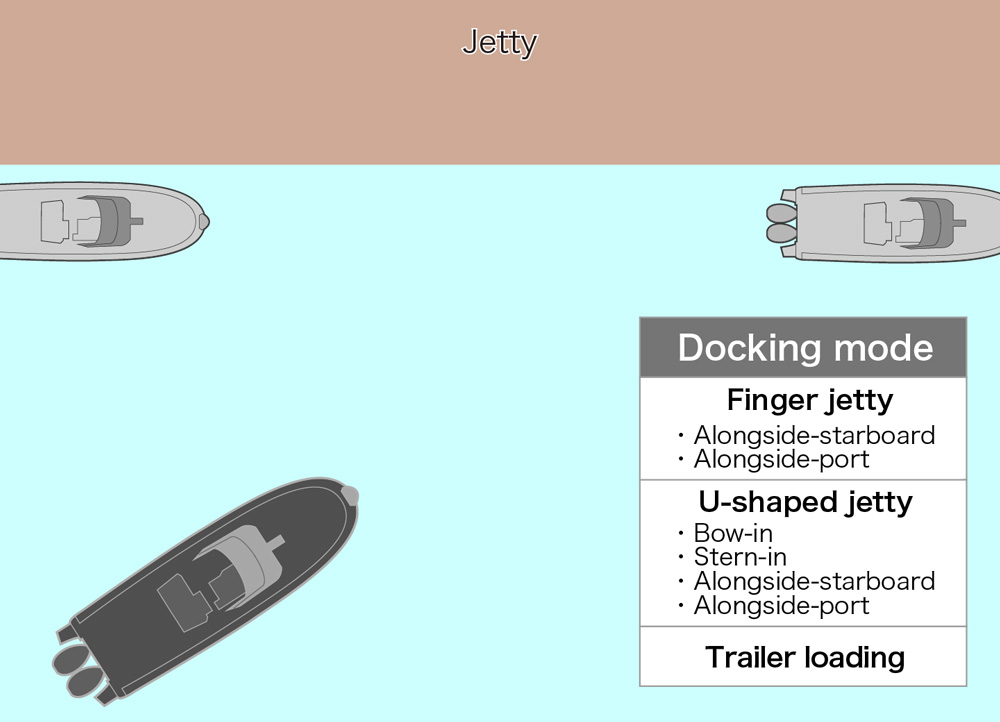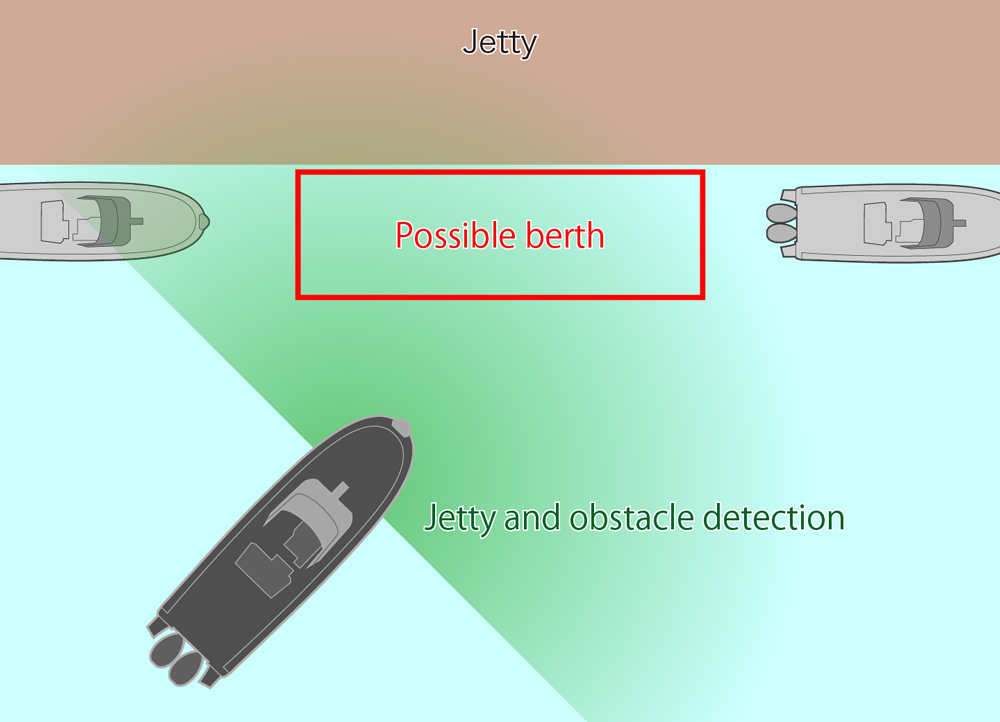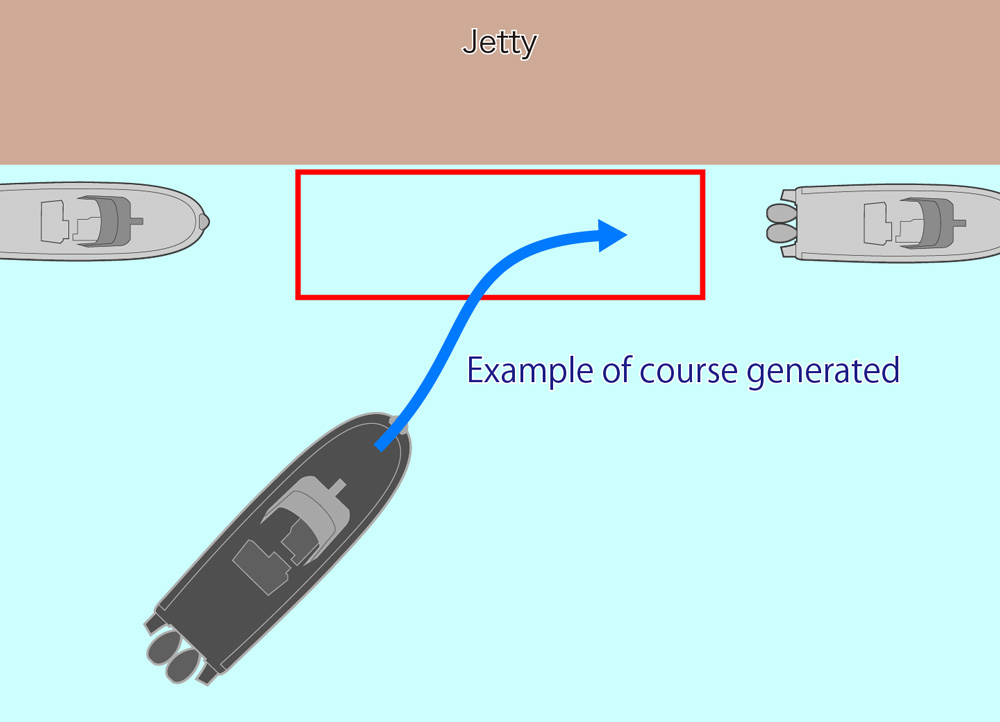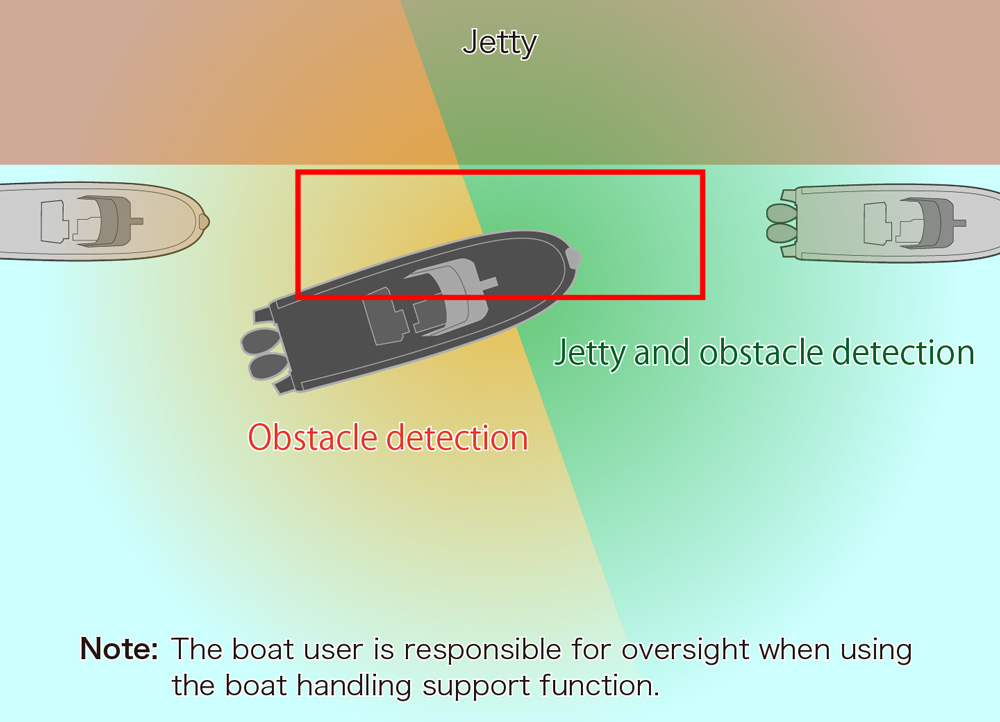
As a support system for handling boats, Advanced Shiphandling Assist Technology makes mobility on the water as much fun as driving a car. By supporting docking and trailer loading operations, which are the most stressful times for boat users*1, this system ensures a stress-free and reassuring marine experience.
*1 According to Honda research.
Applying a human-centered philosophy to search from scratch for the ideal boat handling experience
Ever since it was founded, Honda has always applied a human-centered philosophy to product development. From motorcycles to automobiles, power products, and aircraft, this philosophy is alive in every Honda product, whether on land, on water, or in the air.
While making a name for itself as a power unit manufacturer and provider of outboard motors in the marine products industry, Honda believed that it could leverage its knowledge of other product categories going forward to contribute in the area of human operation of boats, or boat handling.
By also enlisting the help of people previously working in the area of automobile development, including advanced safety technologies, the boat handling support technology development team was able to think outside the box and search from scratch for the ideal boat handling experience that puts people at the center. As a result, the team is researching and developing support technologies that not only lower the barrier to new boat users but provide everyone, including experienced boaters, with peace of mind and comfort.
Supporting difficult docking/undocking operations with advanced technologies cultivated through cars
The difficulty of docking and undocking is taxing on boat users when maneuvering their boats. When on the water, boats are always at the mercy of wind, waves, tides, and other factors. Unlike cars that stand still when the brakes are applied, boats do not remain in the same place by doing nothing, instead requiring advanced boat handling skills.
It takes a lot of experience to read winds and tidal currents from minute changes in the surrounding environment, and then make accurate decisions based on that information, so the docking and undocking operations represent a difficult hurdle to overcome for less experienced boat users.
In fact, according to a survey of pontoon boat*2 users, emotions and stress can be much higher or lower, compared to driving a car, depending on the situation. And at busy marinas and other narrow places where visibility is poor, they need to be constantly maneuvering while avoiding contacting piers or other boats, which puts a lot of strain and stress on the boat users.
Analysis of user emotions when operating a pontoon boat

Low stress when cruising or anchored away from the shore due to good visibility and few obstacles, but tendency toward increased stress on users when docking and undocking due to a greater need for precision in boat handling
To expand the joy and freedom of mobility to water mobility as well, Honda incorporated support technologies, cultivated through cars, into boat handling, which is still taxing for boat users.
*2 Boats with the entire floor area being an open deck. With large decks that can be likened to a “living room on the water,” and offering a wide range of uses for partying on the water, for family leisure activities, or just for cruising, pontoon boats are becoming increasingly popular as a new marine leisure option.
Ergonomic Cockpit feels just like driving a car
Honda wanted to create a boat handling experience where users could tow their boat to a lake, sea, or other body of water with their car and then operate their boat with the same comfort as their car. After a series of verifications of factors that make boat handling difficult for new boat users when docking and undocking, two issues were identified. The first issue was one of cognition, with many blind spots when approaching piers and trailers making it difficult to judge distances. The second issue was one of operability, with the difficulty of finding the optimal sitting posture for handling the boat, and with the low speeds required when docking and undocking making steering and intended boat control more difficult.
Honda pursued support technologies for both visibility and operation, designing a cockpit layout that creates a sitting posture with a greater field of vision and easier handling. The Ergonomic Cockpit System that was developed packaged together a Multi-View Camera System that reduces surrounding blind spots and an Adaptive Steering System in which the ratio of the steering angle to the actual outboard motor (rudder) operating angle changes to create a steering operation that feels very similar to driving a car.
Ergonomic Cockpit System

Cockpit layout
The eye point was one of the criteria used when determining the optimal sitting posture for handling a boat. Pontoon boats have a rectangular deck with protruding corners, so the height of the eye point greatly affects judgment of distances to piers and other objects. For this reason, the eye point was set at an angle that makes it easy to see the display screen and at a height that equates to an 8-meter forward blind spot, making it easy to judge distances.
Next, longitudinal positions were established to enable effortless steering and touch panel operations. Forward, backward, up, and down seat position ranges were set to cover 95% of adult body sizes in North America, with an adjustable footrest added to match seat height. As well as providing a high level of peace of mind through a stable field of vision, this sitting posture makes boat operation easy and less tiring.
Ergonomically designed cockpit layout

Multi-View Camera System
The Multi-View Camera System uses cameras to see to the front, rear, left, and right of the boat, and to show images of around the boat on a display. It comes with a total of five views that can be selected on the display by touch or button operation, including the view below the front of the boat, which can be a blind spot when docking or trailer loading, plus the rear view and a bird’s-eye view looking down on the boat.
The display also has an easy-to-understand layout that brings all the information required for boat handling into a single screen, with use of wind, shift lever position, and other factors enabling an intuitive understanding of the direction the boat is moving. A real-time graphic of the boat shows boat speed, heading, propulsive direction, wind direction and speed, and shift lever position, enabling an understanding of boat behavior at a glance according to wind and propulsive direction.
When approaching a pier or obstacle, a two-level approach notification, depending on distance to the object, warns the boat user to be careful.
Docking View

Docking View provides 360-degree view of the boat when docking

Undocking support with all-around and rear views when moving backward
In Trailer Loading View, an on-screen guide line shows the center of the boat. The boat can be smoothly loaded onto the trailer by lining up the guide line and trailer rails.
Trailer Loading View

The Trailer Loading View includes an on-screen guide line that helps with loading the boat onto the trailer, with a red circle at the bottom of the guide line to indicate the top end of the boat bottom
For pontoon boats in particular, the boat bottom must be accurately aligned with the rail channels, of about 30 cm wide. However, blind spots can make it difficult to understand the relationship between the channels and the boat bottom, creating a tendency to operate the boat with a poor body posture. The Multi-View Camera System enables the boat user to concentrate on boat handling, thereby maintaining a steady posture when steering in different directions to move forward or backward, when trailer loading and at other times, without having to stand or turn around again and again.

Forward visibility ensured when the bow lifts during acceleration or cruising

Wide field of view for checking behind the boat even when cruising
Steering system
The hydraulic system used for steering pontoon boats generally requires five turns of the wheel lock-to-lock. Making sharp turns at low speeds, such as when docking and undocking, therefore requires many turns of the steering wheel. Because steering becomes less effective at low speeds as well, new boat users tend to be slow to operate the controls because of the lack of responsiveness, which can lead to a type of “Dutch roll” with the boat wobbling in all directions as it moves forward. Honda has adopted an Adaptive Steering System for this reason, enabling the steering ratio to be adjusted. Ranging from 2.5 to 4 turns lock-to-lock according to boat speed, the system achieves good maneuverability at low speeds and stability at medium and high speeds.
Auto Docking System provides peace of mind by enabling smooth approaches even in new places
In addition to the Ergonomic Cockpit System that reduces stress when handling the boat, Honda is also working on an Auto Docking System with the potential for automated navigation.
Auto Docking System
The Auto Docking System can take over the docking operation, which is one of the more difficult boat handling skills, to achieve trouble-free docking when using new visitor berths*3 and reduce boat user worry and stress. Enabling docking at a range of berths, including covered berths, and reverse docking as well, this system expands the range of marine experiences possible.
*3 Boats can dock at quay or jetty berths for storage, loading, or unloading.
Supported berthing examples
- Horizontal berths
(with free space fore and aft) - Horizontal berths
(with obstacles fore and aft) - Vertical berths



Using information from a range of sensors, the system accurately estimates the position of the boat and recognizes obstacles and open spaces. It then presents a number of possible berths that take boat size into account. After the user selects a preferred berth and the system generates a course to that berth, automated operation begins. The system will automatically stop the boat if an obstacle is detected.
Illustration
Set docking mode and approach the desired jetty under manual operation.

Possible berths appear on the display when within recognition range.
Select the desired berth on the touch panel.

An automatically generated course appears on the display.
Confirm course and automated docking begins.

Boat docks at the specified berth automatically while detecting the jetty and obstacles.

■When conditions deviate from those required for Auto Docking System use, the system alerts the boat user, who must take over boat handling immediately.
■The Auto Docking System is a boat handling user-assistive system, so there is a limit to the capabilities (e.g. recognition capability and control capability) of its individual functions, and it may not work or may not perform adequately at times.
Auto Trailer Loading System
Like docking, trailer loading is another difficult operation, but this can also be automated. By setting docking mode and selecting the trailer loading option, the camera recognizes the two-dimensional code (2D code) displayed on the trailer and then automatically moves the boat onto the trailer while estimating wind and tidal currents. The system also recognizes the angle of entry, which it adjusts to correct the approach and load the boat straight onto the rails.

Two-dimensional code (2D code) displayed on the trailer acts as a marker
■When conditions deviate from those required for Auto Trailer Loading System use, the system alerts the boat user, who must take over boat handling immediately.
■The Auto Trailer Loading System is a boat handling user-assistive system, so there is a limit to the capabilities (e.g. recognition capability and control capability) of its individual functions, and it may not work or may not perform adequately at times.
Honda wants to become a driving force in society by ensuring joy and freedom of mobility with zero environmental impacts and zero traffic collision fatalities, and by supporting the dreams of people everywhere. This applies not only to cars and bikes, but to the marine environment as well. It is working to further improve safety and comfort on the water by leveraging advanced safety technologies, cultivated through cars, in the development of boat handling support technologies. These technologies represent another important step toward its goal of establishing fully automated boating technologies on the water.